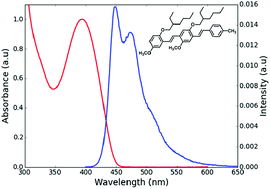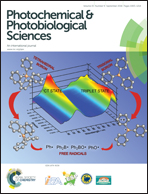The photophysics of phenylenevinylene oligomers and self-absorption of their fluorescence in polymer films
Abstract
The fluorescence spectra, quantum yields and lifetimes of a series of alkoxy-substituted phenylenevinylene molecules, which serve as short chain oligomer models for poly(p-phenylenevinylene), have been determined in fluid solvents and in a high viscosity polymer matrix. The effects of solvent polarity and a high viscosity molecular environment on the fluorescence yields and spectral shapes have been established. Alkoxy group substitution on the phenyl ring moieties of the molecules has an important effect on the vibronic structures and profiles of the absorption spectra. This was interpreted in terms of hot-band, ground to excited singlet state transitions from energetically closely-spaced torsional vibrational levels of the vinylene double bond in the ground state. The shapes of the absorption bands affect the overlaps of the absorption and fluorescence spectra. This has been quantified as the probability of fluorescence reabsorption in solid polymer films as a function of pathlength. This is an important determinant of the efficacies of these compounds for “harvesting” solar energy in luminescent solar concentrator systems. The reabsorption probabilities of these compounds are lower for all pathlengths than those determined in the same polymer film for the fluorophores, perylene and perylene diimide, which have been considered for concentrating spatially diffuse sunlight.


 Please wait while we load your content...
Please wait while we load your content...